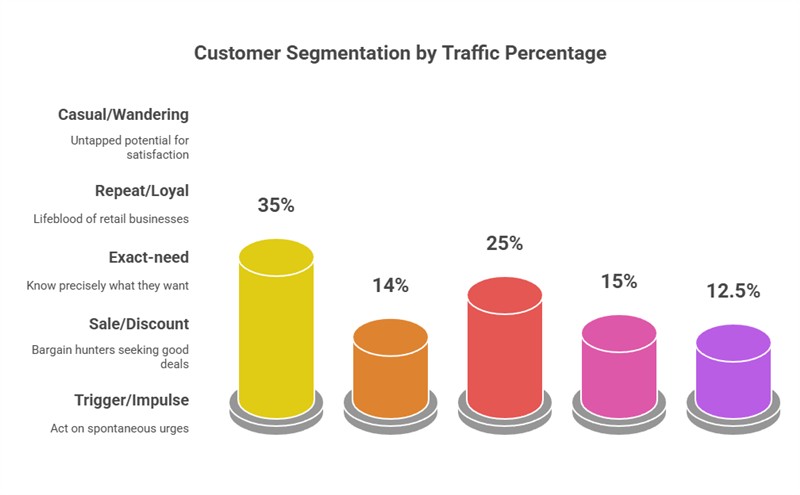This is a popular Customer Modelling System for Australian Retailers. It is built on the behavioural customer types. It categorises shoppers by their motivations and actions in your store, rather than broad traits like age or income.
Segmentation
In your shop, customers can be divided into five key groups based on their behaviour.
You look at the person, categorise them into the relevant group, and then adjust your approach to them based on this segmentation.

The figures below come from a study we did with sensors attached to our POS System.
Casual/Wandering Customers
They make up 30-40% of foot traffic in Australian stores, but their conversion rates are low. Still, they offer untapped potential for satisfaction. Yet these customers represent untapped potential customer satisfaction. I have noticed that just talking to them helps.
Repeat or loyal customers
These are the lifeblood of your retail businesses. Generally they make up about 8-20% of your visitors, but they spend big often 67% more per transaction and what is better they return frequently. They are providing you with stable cash flow.
It is the group that loyalty programs attack as 70% of consumers are influenced by retailer loyalty programs. 35% readily admit it makes them visit more often while 19% state it influences them to spend more.
Exact-need customers
These people know precisely what they want and want quick service. Today they represent about 20-30% of your traffic. COVID turned many customers into this category but since then their numbers have dropped.
If you have what they want they drive moderate but reliable sales. Delays can send them to competitors, so focus on streamlined processes. From my experience, if you see these people in your shop, and you tend to know them by just looking what works well is to ask them direct questions like "What specifications do you need?" or "What price do you have?". Don't waste time up selling initially. They have done their research. Once they commit to a purchase, you can always try to sell them more, e.g. if they want a book by a particular author, once they agree to buy your book, you can always suggest a another similar book.
If these people are a major part of your business, you need fast lanes to cut down lead times. Such efficiency can differentiate your business.
Sale/Discount Customers
These are the bargain hunters, who are on the hunt for good deals. They comprising about 10-20% of traffic. Your POS System can help a lot here to get them into your shop, use flash sales and set up a clearance section in your shop. More here on this. What makes this work well is that this section can be in the worst part of the shop as these people will go there.
If you use them strategically you can move much slow/dead stock.
Trigger/Impulse Customers
These customers act on spontaneous urges, and can add 40% much to your bottom line despite being 10-15% of traffic. If you have interesting gifts you can display on an eye-catching displays, you can make a real winner here.
Now that we've covered the five customer types, let's explore how to put this segmentation into practice in your daily operations.
Implementing segmentation.
Once you are used to this method, it shines in its simplicity as you do not need to worry about demographic models, age or income.


